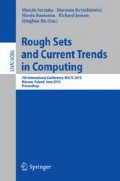Abstract
Support Feature Machines (SFM) define useful features derived from similarity to support vectors (kernel transformations), global projections (linear or perceptron-style) and localized projections. Explicit construction of extended feature spaces enables control over selection of features, complexity control and allows final analysis by any classification method. Additionally projections of high-dimensional data may be used to estimate and display confidence of predictions. This approach has been applied to the DNA microarray data.
Access this chapter
Tax calculation will be finalised at checkout
Purchases are for personal use only
Preview
Unable to display preview. Download preview PDF.
References
Witten, I., Frank, E.: Data Mining: Practical machine learning tools and techniques, 2nd edn. Morgan Kaufmann, San Francisco (2005)
Mierswa, I., Wurst, M., Klinkenberg, R., Scholz, M., Euler, T.: Yale: Rapid prototyping for complex data mining tasks. In: Proc. 12th ACM SIGKDD Int. Conf. on Knowledge Discovery and Data Mining, KDD 2006 (2006)
Berthold, M., Cebron, N., Dill, F., Gabriel, T., Kötter, T., Meinl, T., Ohl, P., Sieb, C., Thiel, K., Wiswedel, B.: KNIME: The Konstanz Information Miner. In: Studies in Classification, Data Analysis, and Knowledge Organization (GfKL 2007). Springer, Heidelberg (2007)
Quinlan, J., Cameron-Jones, R.: Oversearching and layered search in empirical learning. In: Proc. of the 14th International Joint Conference on Artificial Intelligence, pp. 1019–1024. Morgan Kaufmann, San Francisco (1995)
Duch, W., Grudziński, K.: Meta-learning via search combined with parameter optimization. In: Rutkowski, L., Kacprzyk, J. (eds.) Advances in Soft Computing, pp. 13–22. Physica Verlag, Springer, New York (2002)
Grąbczewski, K., Jankowski, N.: Meta-learning with machine generators and complexity controlled exploration. In: Rutkowski, L., Tadeusiewicz, R., Zadeh, L.A., Zurada, J.M. (eds.) ICAISC 2008. LNCS (LNAI), vol. 5097, pp. 545–555. Springer, Heidelberg (2008)
Brazdil, P., Giraud-Carrier, C., Soares, C., Vilalta, R.: Metalearning: Applications to Data Mining. In: Cognitive Technologies. Springer, Heidelberg (2009)
Kuncheva, L.: Combining Pattern Classifiers. Methods and Algorithms. J. Wiley & Sons, New York (2004)
Schölkopf, B., Smola, A.: Learning with Kernels. Support Vector Machines, Regularization, Optimization, and Beyond. MIT Press, Cambridge (2001)
Avnimelech, R., Intrator, N.: Boosted mixture of experts: An ensemble learning scheme. Neural Computation 11, 483–497 (1999)
Duch, W., Itert, L.: Committees of undemocratic competent models. In: Rutkowski, L., Kacprzyk, J. (eds.) Proc. of Int. Conf. on Artificial Neural Networks (ICANN), Istanbul, pp. 33–36 (2003)
Duch, W., Itert, L.: Competent undemocratic committees. In: Rutkowski, L., Kacprzyk, J. (eds.) Neural Networks and Soft Computing, pp. 412–417. Physica Verlag/Springer, Heidelberg (2002)
Smyth, P., Wolpert, D.: Linearly combining density estimators via stacking. Machine Learning 36, 59–83 (1999)
Brown, D.A.: N-bit parity networks. Neural Networks 6, 607–608 (1993)
Grochowski, M., Duch, W.: Learning highly non-separable Boolean functions using Constructive Feedforward Neural Network. In: de Sá, J.M., Alexandre, L.A., Duch, W., Mandic, D.P. (eds.) ICANN 2007. LNCS, vol. 4668, pp. 180–189. Springer, Heidelberg (2007)
Duch, W.: k-separability. In: Kollias, S.D., Stafylopatis, A., Duch, W., Oja, E. (eds.) ICANN 2006. LNCS, vol. 4131, pp. 188–197. Springer, Heidelberg (2006)
Duch, W., Maszczyk, T.: Almost random projection machine. In: Alippi, C., Polycarpou, M., Panayiotou, C., Ellinas, G. (eds.) ICANN 2009. LNCS, vol. 5768, pp. 789–798. Springer, Heidelberg (2009)
Grochowski, M., Duch, W.: Projection Pursuit Constructive Neural Networks Based on Quality of Projected Clusters. In: Kůrková, V., Neruda, R., Koutník, J. (eds.) ICANN 2008, Part II. LNCS, vol. 5164, pp. 754–762. Springer, Heidelberg (2008)
Duch, W., Maszczyk, T.: Universal learning machines. In: Leung, C.S., Lee, M., Chan, J.H. (eds.) ICONIP 2009, Part II. LNCS, vol. 5864, pp. 206–215. Springer, Heidelberg (2009)
Cristianini, N., Shawe-Taylor, J.: An Introduction to Support Vector Machines and other Kernel-Based Learning Methods. Cambridge University Press, Cambridge (2000)
Cover, T.M.: Geometrical and statistical properties of systems of linear inequalities with applications in pattern recognition. IEEE Transactions on Electronic Computers 14, 326–334 (1965)
Sonnenburg, S., Raetsch, G., Schaefer, C., Schoelkopf, B.: Large scale multiple kernel learning. Journal of Machine Learning Research 7, 1531–1565 (2006)
Tebbens, J., Schlesinger, P.: Improving implementation of linear discriminant analysis for the small sample size problem. Computational Statistics & Data Analysis 52, 423–437 (2007)
Robnik-Sikonja, M., Kononenko, I.: Theoretical and empirical analysis of relieff and relieff. Machine Learning 53, 23–69 (2003)
Maszczyk, T., Grochowski, M., Duch, W.: Discovering Data Structures using Meta-learning, Visualization and Constructive Neural Networks. In: Advances in Machine Learning II. Studies in Computational Intelligence, vol. 262, pp. 467–484. Springer, Heidelberg (2010)
Gra̧bczewski, K., Duch, W.: The separability of split value criterion. In: Proceedings of the 5th Conf. on Neural Networks and Soft Computing, Zakopane, Poland, pp. 201–208. Polish Neural Network Society (2000)
Author information
Authors and Affiliations
Editor information
Editors and Affiliations
Rights and permissions
Copyright information
© 2010 Springer-Verlag Berlin Heidelberg
About this paper
Cite this paper
Maszczyk, T., Duch, W. (2010). Support Feature Machine for DNA Microarray Data. In: Szczuka, M., Kryszkiewicz, M., Ramanna, S., Jensen, R., Hu, Q. (eds) Rough Sets and Current Trends in Computing. RSCTC 2010. Lecture Notes in Computer Science(), vol 6086. Springer, Berlin, Heidelberg. https://doi.org/10.1007/978-3-642-13529-3_20
Download citation
DOI: https://doi.org/10.1007/978-3-642-13529-3_20
Publisher Name: Springer, Berlin, Heidelberg
Print ISBN: 978-3-642-13528-6
Online ISBN: 978-3-642-13529-3
eBook Packages: Computer ScienceComputer Science (R0)

